Featured Application
The sustainable synthesis of cyclohexanol and cyclohexanone mixture (ketone and alcohol (KA) oil) is of primordial importance for the synthesis of nylon 6,6. The present industrial process uses a cobalt catalyst, dioxygen as oxidant, requires high temperatures (150 °C), being only able to reach 5–12% yields in order to assure a selectivity of approximately 85%. Thus, more efficient catalytic systems and milder reaction conditions are needed. Herein, an alternative catalytic system based on gold nanotriangles is presented.
Abstract
The search for sustainable catalytic oxidation processes remains a challenge. One process of utmost industrial and economic importance is the selective oxidation of cyclohexane, in the route of nylon-6,6 production, which requires urgent improvement. Herein, Au nanotriangles (Au NTs) were prepared following a three-step (seed preparation, growth and shaping) procedure and applied, for the first time, as catalysts for the selective oxidation of neat cyclohexane to ketone and alcohol (KA) oil (cyclohexanol and cyclohexanone mixture). The Au NTs successfully yield KA oil (up to 14%) under mild conditions (50 °C), using an alternative energy source (microwave irradiation) as reaction promotor.
1. Introduction
Studies on the catalytic properties of gold nanostructures in oxidation reactions showed that such nanoparticles stabilized and well dispersed on various supports (metal oxides [1,2,3,4,5,6], carbon materials [7,8,9,10,11,12], metal–organic frameworks [13], zeolites [14], modified aluminums [15,16], ionic liquids [17], etc.) are able to successfully catalyze several oxidation reactions, as well as the selective partial oxidation of cyclohexane.
The preference for cyclohexane as a model substrate arises from the significance of the oxidized products (cyclohexanol and cyclohexanone) in the production of adipic acid, a building block for different processes in the pharmaceutical, chemical, and food industries. In fact, adipic acid is an important chemical commodity produced globally (over 3.5 million metric tons/year, growing ca. 5%/year) [18,19] mainly in the synthesis of Nylon-6,6 polyamide (primary use), but can also be used in the production of polyurethane resins and polyester [18].
Despite the efforts made to prepare and investigate Au nanocatalysts without any support to assess the activity of pure Au without support effects, the application of gold nanoparticles (Au NPs) in solution as catalysts for oxidation reactions is scarce, mainly due to aggregation issues that induce low reproducibility in the results. So far, Kulikova et al. [20] has disclosed the use of Au NPs stabilized by a 1-dodecanethiol monolayer to catalyze the aerobic oxidation of cyclohexene to produce cyclohexene oxide (11%), alkyl hydroperoxide (84%), and allyl ketone (5%).
It is known that catalytic properties of metal NPs are size- and shape-dependent [21,22]; therefore, the ability to control sizes and morphologies of the Au NPs is an important issue in nanomaterial science. In this work, cetyltrimethylammonium chloride (CTAC)-stabilized Au nanotriangles (Au NTs) were synthetized by a seed-mediated approach and “face-blocking” growth mechanism [23].
The above CTAC-stabilized Au NTs were tested for the microwave (MW)-assisted oxidation of neat cyclohexane to ketone and alcohol (KA) oil under mild conditions using a “green” oxidant (aqueous tert-butylhydroperoxide, TBHP), in contrast to the current inefficient industrial harsher conditions [18,24]. To our knowledge, this is the first time that the successful use of Au NTs for the oxidation of cyclohexane is disclosed.
2. Materials and Methods
All solvents and reagents were obtained from the commercial sources and were used without further purification.
Cetyltrimethylammonium chloride-stabilized gold nanotriangles (CTAC-stabilized Au NTs) were synthetized following a three-step (seed preparation, growth and shaping) procedure previously described in the literature [23]. Briefly, first Au seeds were synthesized by the standard CTAC/NaBH4 procedure; then a “growing solution” (CTAC, HAuCl4 and NaI onto Milli-Q water) and a “shaping solution” (CTAC, HAuCl4 and NaI) were prepared. Ascorbic acid was added to both solutions and were manually stirred until they become colorless (AuIII → AuI). Consequently, 250 µL of seeds were added to solution 1 and manually stirred. Right after, 3.2 mL of solution 1 were added to solution and left to react in the dark during 1 h at room temperature. Finally, to induce flocculation of Au NTs, cetyltrimethylammonium bromide (CTAB) was added until the desired concentration of CTAC+CTAB was reached. The solution was left overnight to flocculate the gold nanotriangles.
Scanning electron microscope (SEM) JEOL 7001F with Oxford light elements, energy dispersive (EDX) detector and electron backscatter diffraction (EBSD) detector (JEOL, Tokyo, Japan) was used to characterize the size distribution and morphology of Au triangles.
Transmission Electron Microscopy (TEM) measurements were carried out on a Transmission Electron Microscope Hitachi 8100 with ThermoNoran light elements EDX detector and digital image acquisition (Hitachi, Tokyo, Japan).
UV-visible spectroscopic measurements of CTAC-stabilized Au NTs aqueous solutions were performed on a PerkinElmer Lambda 750 UV-visible spectrophotometer (PerkinElmer, Inc., Waltham, MA, USA), using a 1 cm path length quartz cuvette.
The catalytic oxidation reactions of cyclohexane were performed in an Anton Paar Microwave 300 reactor (Anton Paar GmbH, Graz, Austria) fitted with a rotational system and an infra-red (IR) temperature detector, in G10 borosilicate glass tubes.
In a typical experiment, were introduced in a 10 mL Pyrex tube a desired volume of Au NTs solution, 5.00 mmol of cyclohexane and 50 μL of nitromethane (as internal standard). The additive (if any) was added and the reaction started by adding TBHP (70% aqueous solution, 10.0 mmol) in one portion. The mixture was irradiated with 10 W and stirred (650 rpm) at the desired temperature (30–70 °C) and reaction time (1–6 h). After the reaction, the obtained mixture was cooled to room temperature and centrifuged. A sample (4 µL) was taken from the organic phase and analyzed by gas chromatography (GC) upon the addition of an excess of PPh3 to reduce cyclohexyl hydroperoxide to cyclohexanol, following a method developed by Shul’pin [25,26]. For the experiments using air as oxidant, atmospheric pressure was used, and the other reaction conditions are the same as the stated before.
GC measurements were performed in a FISONS Instruments GC 8000 series gas chromatograph with a flame ionization (FID) detector and a capillary column (DB-WAX, column length: 30 m; internal diameter: 0.32 mm) and the Jasco-Borwin v. 1.50 software (Jasco, Tokyo, Japan) using helium as the carrier gas. The temperature of injection was 240 °C. The initial temperature was kept at 100 °C for 1 min, then increased 10 °C/min until 180 °C and maintained at this temperature for 1 min. GC-MS analyses were executed in a Perkin Elmer Clarus 600 C instrument (He as the carrier gas). The ionization voltage was 70 eV. GC was conducted in the temperature-programming mode, using an SGE BPX5 column (30 m × 0.25 mm × 0.25 µm). All products formed were identified by comparison of their retention times confirmed with those of commercially available samples. Blank experiments were also carried out, and it was confirmed that in the absence of the Au NTs almost no oxidation products (only up to 1.2%, see Table 1) were obtained. Reaction products mass spectra were compared to fragmentation patterns obtained from the NIST (National Institute of Standards and Technology) spectral library stored in the computer software of the mass spectrometer.

Table 1.
Selected data a for the MW-assisted oxidation of cyclohexane to KA oil catalyzed by Au NTs.
3. Results
Cetyltrimethylammonium chloride-stabilized gold nanotriangles (CTAC-stabilized Au NTs) were synthetized by a 3 steps procedure [23]: seed preparation, growth and shaping (see Scheme 1 and Materials and Methods section).
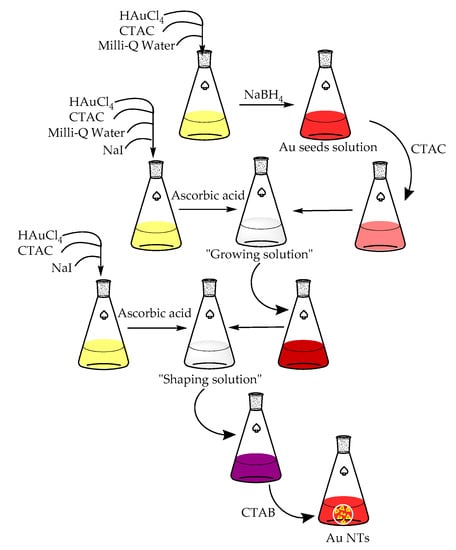
Scheme 1.
Preparation of gold nanotriangles.
“Face-blocking” growth, i.e., directed growth upon selective adsorption of surfactants to most-favorable facets (capping), was chosen as growth mechanism. By this “surfactant-templating”, an initial shape yielded above 50% can be achieved by firstly generating CTAC capped single-twinned seeds (<10 nm) and then fast seed adding to a growth solution using ascorbic acid, yielding nanotriangles of 60–150 nm upon depletion-induced purification. The synthesis process yielded mostly triangles, although hexagons and small polyhedral particles are scarcely detected.
Characterization by TEM and SEM confirm a regular triangular shape of the synthetized CTAC-stabilized Au NTs (Figure 1). High-resolution TEM show nearly 60% of the total nanoparticle population are gold triangles and confirmed the {111} nature of the planar facets of the nanotriangles (Figure 1a) which are very uniform in size distribution and exhibit an edge length of 71 ± 3 nm (Figure 1b) and heights up to 40 nm. Additional TEM images and histogram of Au NTs are depicted in Figure S1 of Supplementary Information.
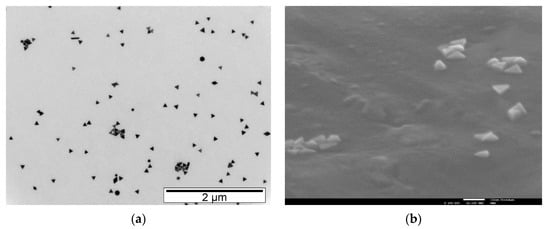
Figure 1.
TEM (a) and SEM (b) images of the obtained CTAC-stabilized Au NTs.
The catalytic performance of the CTAC-stabilized gold nanotriangles was, for the first time, evaluated for the cyclohexane oxidation, in terms of products yield, turnover number (TON, moles of KA oil per mole of catalyst) or frequency (TOF, h−1, TON/reaction time), catalyst amount, and type of oxidant used (see Table 1 and Figure 2, Figure 3, Figure 4 and Figure 5).
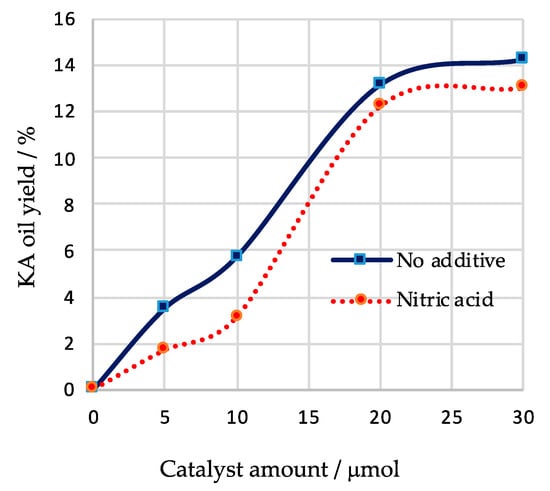
Figure 2.
Effect of the Au NTs amount on the total yield of cyclohexanol and cyclohexanone obtained by MW-assisted oxidation of cyclohexane with TBHP during 3 h at 50 °C using (---) or without (—) nitric acid.

Figure 3.
Influence of the reaction temperature on the yield of KA oil achieved by the Au NTs catalyzed cyclohexane oxidation with TBHP under MW irradiation for 3 h.

Figure 4.
Dependence on the reaction time of the yield of KA oil attained by the Au NTs catalyzed oxidation of cyclohexane with TBHP under MW irradiation at 50 °C.
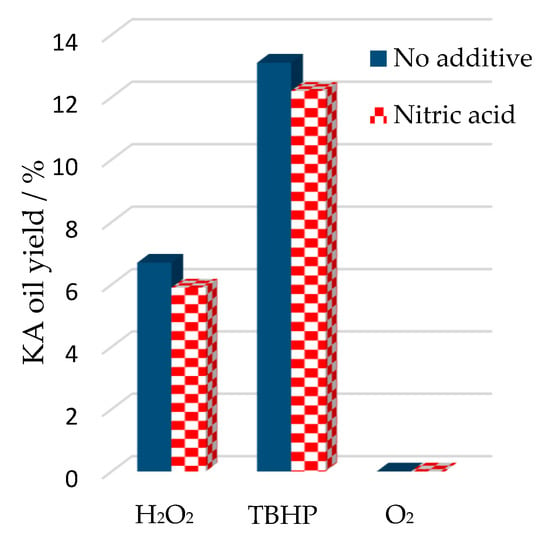
Figure 5.
Influence of the oxidant type on the yield of cyclohexanol and cyclohexanone achieved by the Au NTs catalyzed oxidation of cyclohexane under MW irradiation for 3 h at 50 °C.
The Au NTs show an effective performance as catalysts for the MW-assisted oxidation of cyclohexane, with aqueous tert-butylhydroperoxide (TBHP), to KA oil, through the formation of cyclohexyl hydroperoxide (primary product), under mild conditions (Scheme 2).
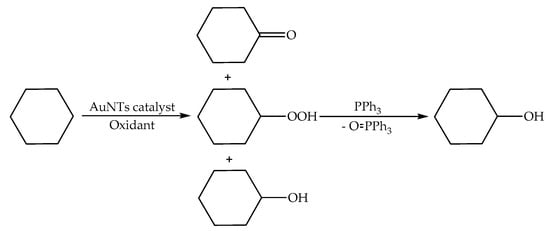
Scheme 2.
Oxidation of cyclohexane with peroxide, catalyzed by Au NTs.
Importantly, the cyclic KA oil are the only products detected by gas chromatographic analysis, confirming the high selectivity of the catalytic oxidative system (please see Table 1). This achieved high selectivity (100% selectivity for the conditions of entry 4, Table 1) is of utmost economic importance since it avoids costly separation steps in the KA oil production process. In addition, the mild conditions used also contribute for a sustainability enhancement of the catalytic process.
The best catalytic conditions consisted of using 20 μmol of catalyst and TBHP (70% aq. solution) as oxidant under MW irradiation at 50 °C for 3 h (Table 1 and Figure 2, Figure 3, Figure 4 and Figure 5).
In fact, the amount of catalyst plays a significant role, as shown in Figure 2. The increase from e.g., 10 to 20 μmol of Au NTs in the reaction medium increases the yield from 5.7 to 13.1%.
The ratio of Au NTs surface to volume per mole of catalyst was determined for the different amounts of catalyst used and is presented in Table 2. Calculations were performed using the Equations S1 and S2 (see Supplementary Information) for the area and volume of an equilateral triangle, respectively.

Table 2.
Au NTs surface/volume ratio per mole of catalyst used for the MW-assisted cyclohexane oxidation to KA oil.
The influence of the TON affected by the surface to volume ratio, on the total yield of products was determined (see Figure S2 of Supplementary Information), and it was found to exhibit a considerable dependence of the catalyst amount.
Moreover, the presence of nitric acid (a commonly used cyclohexane oxidation promotor [27,28]) has a slight inhibitory effect on the catalytic activity of CTAC-stabilized Au NTs as depicted in Figure 2 and entries 5–7 or 15 of Table 1. However, sulfuric acid has a much stronger inhibitory effect than nitric acid (compare entries 8 and 7 of Table 1) reducing the obtained KA oil yield to 3.3% and 12.2%, respectively. Possibly, the inhibiting effect observed is due to the cationic surfactant cetyltrimethylammonium chloride (CTAC) when combined with H2SO4. The complete dissociation of the acids occurs and the pKa of the formed species is higher for sulfuric acid (HSO4; pKa = 1.92) than for nitric acid (weak conjugated base NO3−). This higher value of pH of the reaction mixture probably promotes the decomposition of TBHP.
The catalytic activity of the Au NTs is also sensitive to the reaction temperature and time of MW irradiation, as depicted in Figure 3 and Figure 4, respectively.
The attempts to perform the aerobic catalytic oxidation using the above optimized conditions (20 μmol of Au NTs, 3 h of MW irradiation at 50 °C) failed (see entry 16 of Table 1 and Figure 5). As expected, molecular oxygen is harder to activate than a peroxide compound. Moreover, as presented in Table 3, the pressure when using air as oxidant is much lower than that generated by hydrogen peroxide or TBHP.

Table 3.
MW reactor maximum pressure for the oxidation of cyclohexane to cyclohexanol and cyclohexanone catalyzed by Au NTs.
In addition, the use of the greener hydrogen peroxide (30% aq. solution) oxidant leads to a significant reduction of the KA oil produced (Figure 5). The auto-oxidation of hydrogen peroxide under the optimized conditions for TBHP is known, leading to decrease in the conversion of substrates. Decomposition of H2O2 also prohibits its use at temperatures above 50 °C.
The maximum pressure inside the reactor for the different oxidants is shown in Table 3.
Even using the very low MW irradiation power of 10 W, a favorable effect was observed for the present catalytic system, as reported for other oxidative systems [28,29,30,31,32]. For example, only 2% of product, under the same conditions of those presented in entry 4 of Table 1 but using an oil-bath as heating source (entry 4, Table 4), was obtained. The accelerating effect of microwave-assisted reactions results mainly from (i) the selective absorption of the radiation by polar compounds, (ii) the local overheating (“hot-spot” effect), and (iii) the non-thermal effects such as influence on the pre-exponential factor A in the Arrhenius equation [33].

Table 4.
Selected data a for the oxidation of cyclohexane to cyclohexanol and cyclohexanone during 3 h at 50 °C using conventional heating.
It is also worth to notice that the attained maximum yield value in the present study is also higher than the reported [34] for the currently industrial (commercial) process with the advantage of being much more selective (100% selectivity was obtained, see entry 4 of Table 1) and obtained under mild conditions.
The stability of the gold nanotriangles in the oxidative reaction medium was assessed by UV-vis spectrophotometry, through the localized surface plasmonic resonance (LSPR) of the AuNTs before and after the reaction. As depicted in Figure 6, after the catalytic reaction, only a very small λmax shift from 533 nm (before the reaction) to 536 nm (after the reaction) of the LSPR was detected. As a common rule, bigger nanoparticles, as well as more complex morphologies, lead to longer red-shifted absorptions in the LSPR and therefore no significant aggregation of the Au NTs appears to occur during the catalytic reaction.
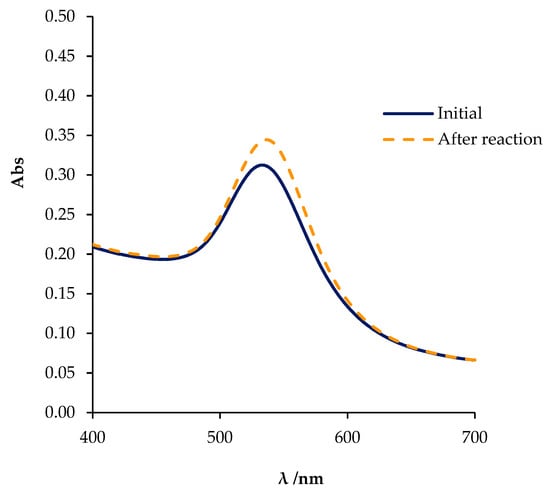
Figure 6.
Absorption spectra (400 – 700 nm) of the Au NTs before and after the catalytic oxidation reaction.
By analogy with reported mechanisms for different types of Mn/n−1 metal systems [6,7,35], the proposed mechanism for the present Au NTs/TBHP system follows (reactions (1)–(9), Scheme 3).
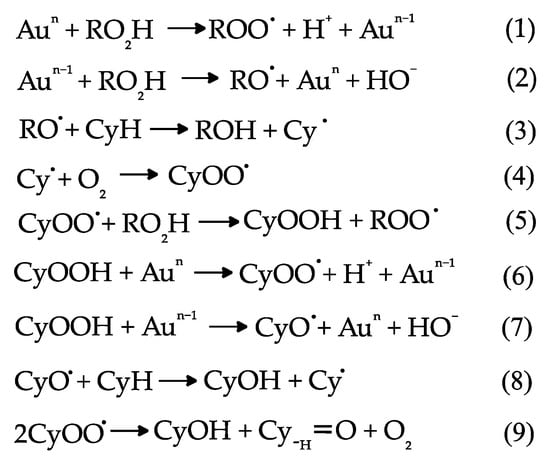
Scheme 3.
Suggested mechanism for cyclohexane oxidation catalyzed by Au NTs.
Firstly, Au-catalyzed decomposition of TBHP occurs, leading to ROO and RO radicals upon oxidation by Aun or reduction by An−1 according to reactions (1) and (2), respectively. Then, H-abstraction from CyH by RO leads to the formation of cyclohexyl radical (Cy) (reaction (3)). CyOO is formed by the reaction of Cy with dioxygen (reaction (4)), and CyOOH can then be formed upon H-abstraction from TBHP by CyOO (reaction (5)). Au-assisted decomposition of CyOOH to CyOO and CyO (reactions (6) and (7)) leads to the formation of the desired products: cyclohexanol (CyOH) and cyclohexanone (Cy−H=O), according to reactions (8) and (9)).
This work created the possibility of using non-supported gold nanoparticles towards cyclohexane oxidation under mild conditions using peroxide as oxidant. The combination of suitable Au NPs, such as CTAC-stabilized Au NTs, and well-adjusted reaction parameters (in particular, the use of MW irradiation) can lead to highly selective and efficient catalytic systems with significance for the development of a sustainable process for cyclohexane oxidation to KA oil.
In fact, the following advantages of using Au NTs instead of spherical Au NPs can be considered: (i) for the same diameter, triangular nanoplates present more gold atoms at the nanoparticle surface when compared with nanospheres and circular nanoplates; (ii) despite being stable, gold nanotriangles are less stable than small gold nanospheres and therefore easier to separate from solution by centrifugation (expensive and not an easy-to-scale process), which can be important for reusing these materials at an industrial level; and (iii) anisotropic materials such as nanotriangles present hot-spots that can concentrate the energy. This can be important to favor the reaction.
Supplementary Materials
The following are available online at http://www.mdpi.com/2076-3417/8/12/2655/s1, Figure S1: Additional Transmission Electron Microscopy (TEM) images (a) and (b) and histogram (c) of Au NTs, Figure S1: Dependence of turnover number (TON) affected by the surface to volume ratio, on the total yield of products.
Author Contributions
Conceptualization, A.P.C.R. and R.P.O.-S.; methodology, I.A.S.M.; formal analysis, A.P.C.R. and R.P.O.-S.; investigation, A.P.C.R., I.A.S.M. and R.P.O.-S.; writing—original draft preparation, L.M.D.R.S.M.; writing—review and editing, L.M.D.R.S.M.; supervision, L.M.D.R.S.M. and D.M.F.P.; project administration, L.M.D.R.S.M.; funding acquisition, L.M.D.R.S.M.
Funding
This research was funded by the Fundação para a Ciência e a Tecnologia (FCT), Portugal: projects UID/QUI/00100/2013, UID/BIO/04565/2013 and PTDC/QEQ-ERQ/1648/2014 and fellowships SFRH/BPD/90883/2012 to APCR and PD/BD/116850/2016 to RP Oliveira-Silva. Funding received by IBB-Institute for Bioengineering and Biosciences from Programa Operacional Regional de Lisboa 2020 (Project N. 007317) is also acknowledged.
Conflicts of Interest
The authors declare no conflict of interest.
References
- Carneiro, J.T.; Savenije, T.J.; Moulijn, J.A.; Mul, G. The effect of Au on TiO2 catalyzed selective photocatalytic oxidation of cyclohexane. J. Photochem. Photobiol. 2011, 217, 326–332. [Google Scholar] [CrossRef]
- Hereijgers, B.P.C.; Weckhuysen, B.M. An attempt to selectively oxidize methane over supported gold catalysts. J. Catal. 2010, 270, 16–25. [Google Scholar] [CrossRef]
- Alshammari, A.; Koeckritz, A.; Kalevaru, V.N.; Bagabas, A.; Martin, A. Significant formation of adipic acid by direct oxidation of cyclohexane using supported nano-gold catalysts. ChemCatChem 2012, 4, 1330–1336. [Google Scholar] [CrossRef]
- Conte, M.; Liu, X.; Murphy, D.M.; Whiston, K.; Hutchings, G.J. Cyclohexane oxidation using Au/MgO: An investigation of the reaction mechanism. Phys. Chem. Chem. Phys. 2012, 14, 16279–16285. [Google Scholar] [CrossRef]
- Liu, X.; Conte, M.; Sankar, M.; He, Q.; Murphy, D.M.; Morgan, D.; Jenkins, R.L.; Knight, D.; Whiston, K.; Kiely, C.J.; Hutchings, G.J. Liquid phase oxidation of cyclohexane using bimetallic Au-Pd/MgO catalysts. Appl. Catal. 2015, 504, 373–380. [Google Scholar] [CrossRef]
- Martins, L.M.D.R.S.; Carabineiro, S.A.C.; Wang, J.; Rocha, B.G.M.; Maldonado-Hódar, F.J.; Pombeiro, A.J.L. Supported gold nanoparticles as reusable catalysts for oxidation reactions of industrial significance. ChemCatChem 2017, 9, 1211–1221. [Google Scholar] [CrossRef]
- Ribeiro, A.P.C.; Martins, L.M.D.R.S.; Carabineiro, S.A.C.; Figueiredo, J.L.; Pombeiro, A.J.L. Gold nanoparticles deposited on surface modified carbon xerogels as reusable catalysts for cyclohexane C-H activation towards CO and water. Molecules 2017, 22, 603. [Google Scholar] [CrossRef]
- Ribeiro, A.P.C.; Martins, L.M.D.R.S.; Carabineiro, S.A.C.; Figueiredo, J.L.; Pombeiro, A.J.L. Gold nanoparticles deposited on surface modified carbon materials as reusable catalysts for hydrocarboxylation of cyclohexane. Appl. Catal. A Gen. 2017, 547, 124–131. [Google Scholar] [CrossRef]
- Carabineiro, S.A.C.; Martins, L.M.D.R.S.; Avalos-Borja, M.; Buijnsters, J.G.; Pombeiro, A.J.L.; Figueiredo, J.L. Gold nanoparticles supported on carbon materials for cyclohexane oxidation with hydrogen peroxide. Appl. Catal. 2013, 467, 279–290. [Google Scholar] [CrossRef]
- Xu, Y.J.; Landon, P.; Enache, D.; Carley, A.F.; Roberts, M.W.; Hutchings, G.J. Selective conversion of cyclohexane to cyclohexanol and cyclohexanone using a gold catalyst under mild conditions. Catal. Lett. 2005, 101, 175–179. [Google Scholar] [CrossRef]
- Hutchings, G.J.; Carrettin, S.; Landon, P.; Edwards, J.K.; Enache, D.; Knight, D.W.; Xu, Y.-J.; Carley, A.F. New approaches to designing selective oxidation catalysts: Au/C a versatile catalyst. Top. Catal. 2006, 38, 223–230. [Google Scholar] [CrossRef]
- Mayani, V.J.; Mayani, S.V.; Kim, S.W. Palladium, Gold, and Gold–Palladium Nanoparticle-Supported Carbon Materials for Cyclohexane Oxidation. Chem. Eng. Commun. 2015, 203, 539–547. [Google Scholar] [CrossRef]
- Sun, Z.G.; Li, G.; Liu, L.P.; Liu, H.O. Au nanoparticles supported on Cr-based metal-organic framework as bimetallic catalyst for selective oxidation of cyclohexane to cyclohexanone and cyclohexanol. Catal. Commun. 2012, 27, 200–205. [Google Scholar] [CrossRef]
- Saxena, S.; Singh, R.; Pala, R.G.S.; Sivakumar, S. Sinter-resistant gold nanoparticles encapsulated by zeolite nanoshell for oxidation of cyclohexane. RSC Adv. 2016, 6, 8015–8020. [Google Scholar] [CrossRef]
- Zhao, J.; Zhu, M.; Chen, J.; Yang, Y.; Tang, Y.; Cai, Z.; Shen, Y.; He, C. In Fundamental of Chemical Engineering; Cao, Z., Sun, L., Cao, X.Q., He, Y.H., Eds.; TransTec Publications Inc.: Zurich, Switzerland, 2011; Volume 233–235, pp. 254–259. [Google Scholar]
- Xu, L.-X.; He, C.-H.; Zhu, M.-Q.; Fang, S. A highly active Au/Al2O3 catalyst for cyclohexane oxidation using molecular oxygen. Catal. Lett. 2007, 114, 202–205. [Google Scholar] [CrossRef]
- Hosseini-Monfared, H.; Meyer, H.; Janiak, C. Dioxygen oxidation of 1-phenylethanol with gold nanoparticles and N-hydroxyphthalimide in ionic liquid. J. Mol. Catal. 2013, 372, 72–78. [Google Scholar] [CrossRef]
- Elvers, B. Ullmann’s Encyclopedia of Industrial Chemistry, 6th ed.; Ullmann, F., Hawkins, S., Schula, G., Gerhartz, W., Russey, W.E., Elvers, B., Eds.; Wiley-VCH: Weinheim, Germany, 2016; Volume 11, pp. 41–49. [Google Scholar]
- Adipic acid (ADPA): 2016 World Market Outlook and Forecast up to 2020; Merchant Research and Consulting: Birmingham, UK, 2016.
- Kulikova, V.S.; Shestakov, A.F. Functionalization of alkanes by gold nanoparticles stabilized by 1-dodecanethiol in organic media. Russ. J. Phys. Chem. B 2007, 1, 507–511. [Google Scholar] [CrossRef]
- Sun, Y.G.; Xia, Y.N. Shape-Controlled Synthesis of Gold and Silver Nanoparticles. Science 2002, 298, 2176–2179. [Google Scholar] [CrossRef]
- Priecel, P.; Salami, H.A.; Padilla, R.H.; Zhong, Z.Y.; Lopez-Sanchez, J.A. Anisotropic gold nanoparticles: Preparation and applications in catalysis. Chin. J. Catal. 2016, 37, 1619–1650. [Google Scholar] [CrossRef]
- Scarabelli, L.; Coronado-Puchau, M.; Giner-Casares, J.J.; Langer, J.; Liz-Marzán, L.M. Monodisperse gold nanotriangles: Size control, large-scale self-assembly, and performance in surface-enhanced Raman scattering. ACS Nano 2014, 8, 5833–5842. [Google Scholar] [CrossRef]
- Weissermel, K.; Arpe, H.J. Industrial Organic Chemistry, 2nd ed.; Weissermel, K., Arpe, H.J., Eds.; Wiley-VCH: Weinheim, Germany, 1993; ISBN 3-527-26995-9. [Google Scholar]
- Shul’pin, G.B.; Nizova, G.V. Formation of alkyl peroxides in oxidation of alkanes by H2O2 catalyzed by transition metal complexes. React. Kinet. Catal. Lett. 1992, 48, 333–338. [Google Scholar] [CrossRef]
- Shul’pin, G.B.; Matthes, M.G.; Romakh, V.B.; Barbosa, M.I.F.; Aoyagi, J.L.T.; Mandelli, D. Oxidations by the system ‘hydrogen peroxide-[Mn2L2O3][PF6]2 (L=1,4,7-trimethyl-1,4,7-triazacyclononane)-carboxylic acid’. Part 10: Co-catalytic effect of different carboxylic acids in the oxidation of cyclohexane, cyclohexanol, and acetone. Tetrahedron 2008, 64, 2143–2152. [Google Scholar] [CrossRef]
- Martins, L.M.D.R.S.; Pombeiro, A.J.L. Water-soluble C-scorpionate complexes: Catalytic and biological applications. Eur. J. Inorg. Chem. 2016, 2236–2252. [Google Scholar] [CrossRef]
- Sabbatini, A.; Martins, L.M.D.R.S.; Mahmudov, K.T.; Kopylovich, M.N.; Drew, M.G.B.; Pettinari, C.; Pombeiro, A.J.L. Microwave-assisted and solvent-free peroxidative oxidation of 1-phenylethanol to acetophenone with a Cu(II)-TEMPO catalytic system. Cat. Com. 2014, 48, 4048–4058. [Google Scholar] [CrossRef]
- Sutradhar, M.; Martins, L.M.D.R.S.; Guedes da Silva, M.F.C.; Liu, C.-M.; Pombeiro, A.J.L. Trinuclear Cu(II) structural isomers: Coordination, magnetism, electrochemistry and catalytic activity toward oxidation of alkanes. Eur. J. Inorg. Chem. 2015, 3959–3969. [Google Scholar] [CrossRef]
- Mahmudov, K.T.; Kopylovich, M.N.; Sabbatini, A.; Drew, M.G.B.; Martins, L.M.D.R.S.; Pettinari, C.; Pombeiro, A.J.L. Cooperative metal-ligand assisted E/Z isomerisation and cyano-groups activation at CuII and CoII complexes of arylhydrazones of active methylene nitriles. Inorg. Chem. 2014, 53, 9946–9958. [Google Scholar] [CrossRef]
- Timokhin, I.; Pettinari, C.; Marchetti, F.; Pettinari, R.; Condello, F.; Galli, S.; Alegria, E.C.B.A.; Martins, L.M.D.R.S.; Pombeiro, A.J.L. Novel coordination polymers with (pyrazolato)-based tectons: Catalytic activity in the peroxidative oxidation of alcohols and cyclohexane. Cryst. Growth Des. 2015, 15, 2303–2317. [Google Scholar] [CrossRef]
- Kopylovich, M.N.; Mahmudov, K.T.; Silva, M.F.C.G.; Martins, L.M.D.R.S.; Kuznetsov, M.L.; Silva, T.F.S.; Fraústo da Silva, J.J.R.; Pombeiro, A.J.L. Trends in properties of para-substituted 3-(phenylhydrazo)pentane-2,4-diones. J. Phys. Org. Chem. 2011, 24, 764–773. [Google Scholar] [CrossRef]
- Bäckwall, J.-E. (Ed.) Modern Oxidation Methods; Wiley-VCH: Weinheim, Germany, 2004. [Google Scholar]
- Ullmann’s Encyclopedia of Industrial Chemistry, 6th ed.; Wiley-VCH: Weinheim, Germany, 2016; Volume 11, pp. 41–49.
- Martins, L.M.D.R.S.; Pombeiro, A.J.L. Tris(pyrazol-1yl)methane metal complexes for catalytic mild oxidative functionalizations of alkanes, alkenes and ketones. Coord. Chem. Rev. 2014, 265, 74–88. [Google Scholar] [CrossRef]
© 2018 by the authors. Licensee MDPI, Basel, Switzerland. This article is an open access article distributed under the terms and conditions of the Creative Commons Attribution (CC BY) license (http://creativecommons.org/licenses/by/4.0/).